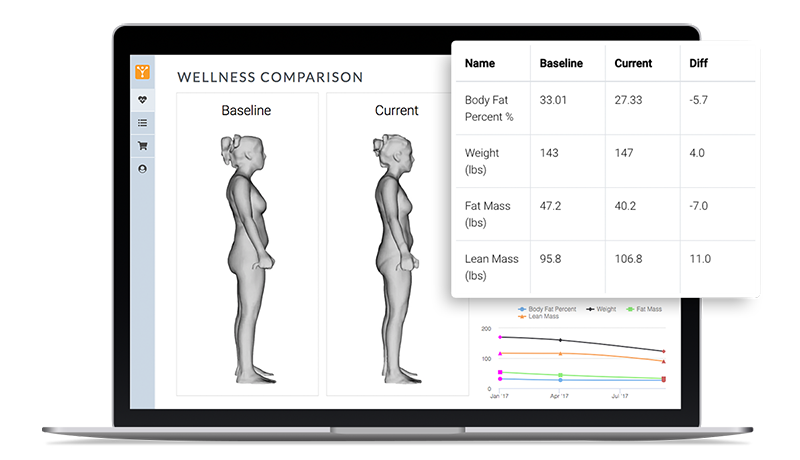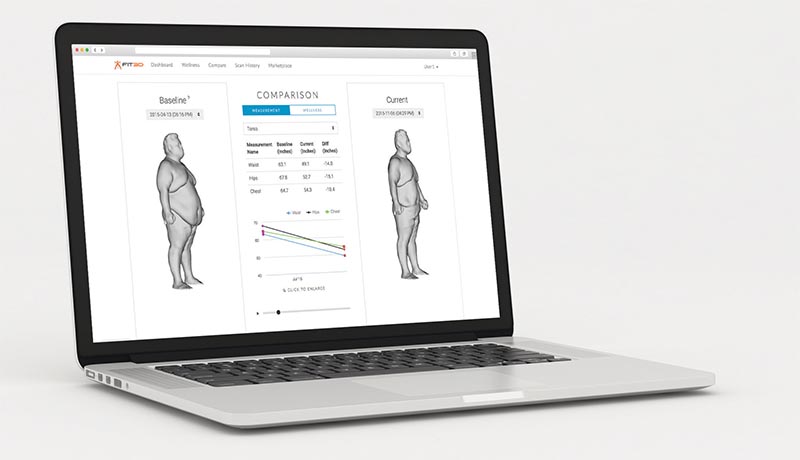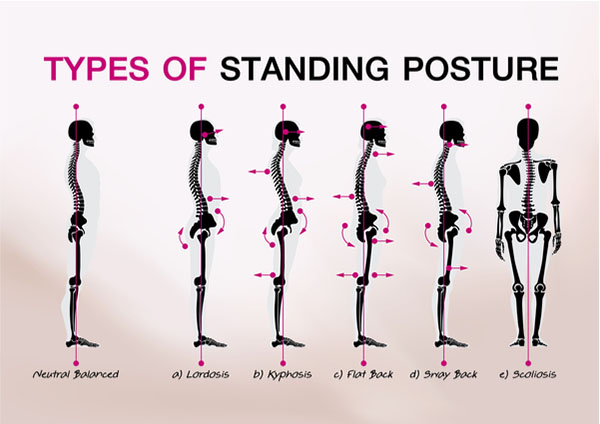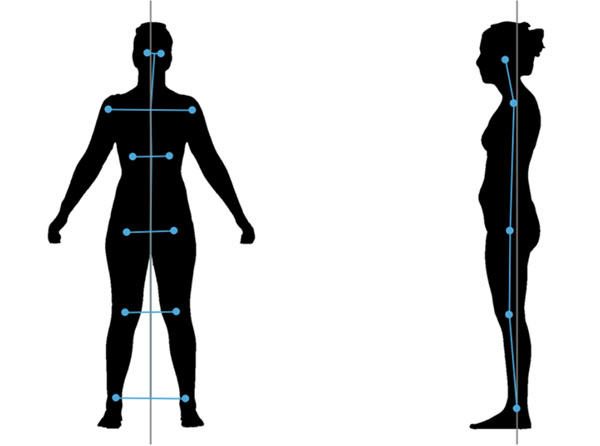In a single 40 second, non-invasive scan, members can capture circumference measurements, body composition, posture analysis, Body Shape Rating (BSR), Basal Metabolic Rate (BMR) and much more. It also shows you how you compare against healthy ranges and against others of your same gender and age.
Plus, a 3D avatar to help you visually track your progress from any device anywhere in the world. You will be able to compare your baseline scan to any future scan so you can easily monitor, track and see the progress you’re making toward your fitness goals!


As a Spunk Fitness member, you will get a FIT-3D full body scan, a $200 value – at no additional cost to you with each fitness consultation purchased.
See how the FIT-3D Body Scan woks by clicking HERE txhd.io/s/#49iV
Sign-up for your FIT-3D Body Scan HERE txhd.io/s/#QbJA
I wish I had a dime for every time my Dad said to sit up straight at the table, or my Mom told me to keep my shoulders back. They wanted me to have good table manners and look confident, but perhaps they also knew what science has now taught us: good posture has many health benefits and poor posture can severely limit your mobility — particularly as you age.
Good posture keeps your bones and joints in good alignment and reduces wear and tear on joint surfaces. It also decreases the stress on ligaments. According to Livestrong.com, good posture improves the efficiency of oxygen flow to your nervous system, organs, and other tissues. It can help prevent future health issues like spinal disk problems and constricted blood vessels and nerves. Muscle & Fitness also points out that good posture improves digestion and reduces acid reflux because it enables organs to sit in their natural position without compression.
How is Your Posture?
Most people think little about their posture until they begin having chronic back or neck pain. A posture analysis can help identify your risk for problems like kyphosis (commonly known as roundback) that affect mobility. According to the University Spine Center, sufferers of Kyphosis often slouch and struggle with breathing problems, back pain and tenderness, and stiffness. The effects of which can be reduced with physical therapy and exercise.

Your knees are also vulnerable to the effects of poor posture. A posture analysis can help you identify health problems like over-pronation of the feet, which can cause your knees to fall inwards. According to Ask the Trainer, this is a common sports injury caused by poor posture. The Foot Posture Center warns that the “majority of knee pain cases are directly related to poor foot posture and it is vital that this is corrected naturally before opting for medication or surgery.”
Finally, and perhaps most common, poor posture causes shoulder problems. The shoulder is made up of three bones, the clavicle (collarbone), scapula (shoulder blade), and the humerus (arm bone) that are held together by the rotator cuff. As any of you who have had shoulder injuries know, the shoulder is a complex and delicate joint. Poor posture frequently causes shoulder impingement — which not only causes pain — it can make it difficult for you to raise your arms above your head. If unidentified and untreated, it will wear down the tendons in the shoulder (called bursa). A Fit3D Posture Analysis can get you ahead of all these risks.

Why Fit3D for Your Posture Analysis?
As part of the 3D body surface scan, the Fit3D ProScanner includes an assessment of your full body posture, from eyes and ears to feet. Unlike other tools that evaluate posture, the Fit3D ProScanner analyzes the position of your ears and eyes as a baseline, which provides important insight into your head and neck positioning. Our Posture Analysis evaluates your shoulders, hips, knees, and ankle positions when you are standing. It also provides posture Wellness Metrics on body shape, waist circumference, waist to hip and trunk to leg volume ratios, and more.
This is particularly important for people with mobility issues, chronic neck, back, and other joint pain. A posture analysis can help you focus your time in the gym and during physical therapy on the right activities to strengthen your core. Over time, as your fitness and health improve, you can take repeat scans to see changes and further calibrate your posture. The Fit3D ProScanner Posture Analysis is the only one of its kind that visualizes your changes with an avatar.
Lastly, and perhaps most importantly for your staff, the Fit3D ProScanner automates the entire process of analysis. Using the app with an intuitive interface, our system provides a report with an in-depth level of analysis that would typically require a clinician to determine.
Body Shape Rating (BSR) is a wellness score based on the relationship of your body shape to cardiovascular-related risk factors. It answers the question, is my body shape making it more likely for me to potentially develop certain cardiovascular related health issues? BSR is on a 0-100 range where 50 is average and the higher the score the lower the risk.
Trunk to Leg Volume Ratio compares the volume of your trunk with the volume of your legs. Research claims that having a high percentage of your body’s volume in your torso compared to your legs increases the likelihood of you experiencing prediabetes, diabetes, high triglyceride (fat) counts, high blood pressure, metabolic syndromes, and other severe health complications.
Weight in Your Midsection is highly correlated with visceral fat, which is the unhealthy fat around your organs. This can lead to many negative health effects. If you have a big belly and smaller legs, it is a good assumption that your weight is centered around your midsection and is, therefore, visceral fat.
The BSR formula is dependent on volume, not weight. The primary way to improve your BSR is to increase the density of your body by increasing the muscle in your legs and decreasing your waist circumference. This can be done through a balanced mix of good nutrition and exercise. Consult with your trainer, nutritionist, coaches, or doctors to set up a plan.
Body Fat Percentage (BFP) is the user’s total fat mass divided by the total body mass. Fat is an essential component of the body and is necessary to maintain life and reproductive functions; however, too much body fat can negatively affect overall health or hormone levels. It also serves as an indicator of more serious health problems that could potentially be faced in the future.
- Fat mass is also known as adipose tissue within the body. This loose connective tissue is primarily composed of adipocytes (fat cells). Its main role is to store energy in the form of lipids. It also cushions and insulates the body.
- Body fat is primarily made up of three types of fat:
Epicardial Adipose Tissue (EAT): EAT is a particular form of visceral fat deposited around the heart and is found to be a metabolically active organ that generates various bioactive molecules, which may significantly affect cardiac function.
Subcutaneous Fat: The fat that is generally stored just below the surface of the skin. Subcutaneous fat is not related to many of the classic obesity-related pathologies, such as heart disease, cancer, and stroke and is generally a protective fat.
Ectopic Fat: The storage of triglycerides (fats) in tissues other than adipose tissue that are only supposed to contain small amounts of fat, such as the liver, skeletal muscle, heart, and pancreas. These fats can interfere with cellular function. The cause for accumulation of Ectopic fat is unknown.
You can decrease your body fat percentage through a balanced mix of good nutrition and exercise that includes higher intensity interval training and cardio. Consult with your trainer, nutritionist, coaches, and/or doctors to set up a plan.
Lean Mass is the muscle tissue, skeletal tissue, and water in the body
You can increase your lean mass by participating in health and fitness programs that include weight training. You can also talk with your nutritionist to develop a nutrition program that will effectively build lean mass. If you are simply looking to build lean mass, but not necessarily lose fat mass, your program may be quite different than a program that is geared towards a more balanced fat percentage reduction. Consult with your trainer, nutritionist, coaches, and/or doctors to set up a plan.
Basal Metabolic Rate (BMR) is the amount of energy expended while at rest in a neutrally temperate environment and in the postabsorptive state. In this state, the digestive system is inactive, which is usually achieved by about twelve hours of fasting. Furthermore, BMR is the amount of energy expressed in calories that a person needs to keep the body functioning (i.e. breathing, blood circulation, controlling body temperature, cell growth, brain and nervous function, and contraction of muscles). BMR affects the rate at which a person burns calories and ultimately affects whether that individual maintains, gains, or loses weight.
